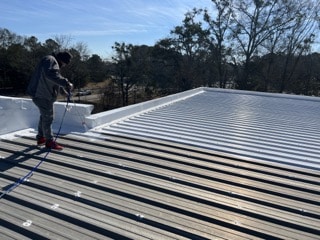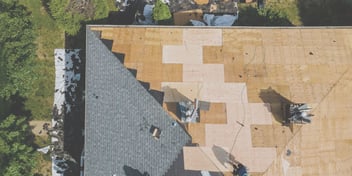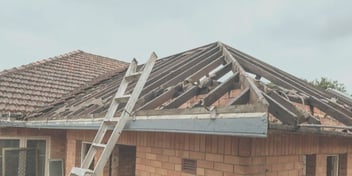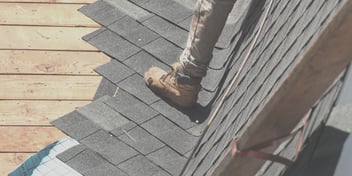- Home »
- Learningcenter »
- When should i replace my roof
When Should I Replace My Roof?

When Does a Roof Need To Be Replaced?
A roof is protection from the elements, it’s the essence of shelter. It’s something that you don’t think about most days—something that you hope to never think about—but when it’s a problem, it’s a MAJOR problem.
When a roof is working properly it is out of sight and out of mind, but when it’s not, you’ve got problems. Drips coming through the ceiling, mold building up in the attic, a damaged and sagging roof, and you could possibly have a major disaster.
So when does a roof need to be replaced? Here are the telltale signs that you need a roof replacement:
#1. Your Roof Is Simply Beyond Its Prime
Roofs don’t last forever, as much as we would like it if they did. Shingles wear out, metal rusts, tiles break. Over time, even if you stay on top of proper maintenance procedures, your roof is eventually going to need to be replaced.
How often does this need to happen? Well here are some general ideas about the lifespan of different roofing materials and when it’s time to replace:
- Asphalt Shingle Roofs: these should last between 15 to 25 years, depending on weather conditions, proper maintenance, and the quality of materials.
- Tile Roofs: these last longer than shingle roofs, at about 20 to 35 years–but they are susceptible to damage, especially from windstorms
- Metal Roofs: metal roofs last longest of the bunch, depending on the type of metal used and the proper connectors. A good metal roof will last anywhere from 40 years to 70 years.
- Wood Shake Roofs: these less-common roofs are beautiful, but they’re susceptible to damage and need occasional repairs. A shake roof will last around 20 years.
- Slate Roofs: One of the least common types of roofs, primarily because they’re so expensive, a slate roof actually will last quite a long time. Figure about 40 to 60 years.
#2. Storm Damage
Storm damage is probably the number one most common reason why roofs need to be replaced, other than age. Whether the storm is tearing off shingles and shakes, or dropping branches on the roof, or pouring constant rain, a storm can do significant damage to a roof.
After a big storm, especially a windstorm, go outside and walk around your home looking for anything that is wrong, particularly fallen branches or missing shingles. If you spot either of these, then call Colony Roofers right away. A missing shingle may not look like much of a problem, but if you get more rain then that shingle may be the hole in the protective coating surrounding your home, keeping it free from water damage.
And that fallen branch may seem like a little thing, too, but if it impacted the roof in just the right way it could have torn a hole not only in the asphalt shingle, but also in the tar paper underlayment below the shingles. That hole could mean a big leak.
(And don’t think because you don’t have shingles means you don’t need to watch out for these things. Broken tiles are just as bad as missing shingles, and a fallen branch can puncture a metal roof if a jagged piece of wood impacts it in the right place.)
#3. Deterioration
You should be cleaning out your rain gutters regularly, or paying someone to do it. A big hint that your shingle roof is getting old and is in need of replacement is if you start to see the accumulation of little granules and grit flowing down from the shingles and into the gutter. This is probably the biggest–and easiest–warning sign for you to watch out for when you’re determining the life of your roof.
Catching a deteriorating roof when it’s just beginning to shed granules is like catching a mole before it turns into skin cancer. You can get it treated easily, in and out of the doctor’s office in a day, instead of an expensive and invasive procedure. Don’t wait for it to get bad. Get a roof inspection from a roofing contractor at Colony Roofers
#4. Sagging
If your roof is sagging, then you need to call Colony Roofers right away. A sagging roof means that there’s something wrong with the structure of the roof, either in the sheathing or the trusses. And the most common reason for sagging problems is water damage. You’re roof is leaking and in a bad way.
If you ignore a sagging roof, it’s not going to go away. What’s going to happen is that the roof is going to collapse one day and you’ll be seeing sunlight from inside your bedroom.
Any amount of sagging is cause for concern. Don’t go up on the roof to check it out for yourself, because you already know that the structure is in danger. Call the professionals who will have the right safety equipment and know how to diagnose and do roof repairs.
#5. Water Dams
You may not think about this much, but if you get a dam forming on your roof, water can back up and get inside where it shouldn’t be. This can happen either with debris (such as leaves piling up behind a chimney or against a gable) or a frozen patch from an ice storm.
Roofs are made for water to flow down, running off the shingles like off the feathers of a duck’s back. But when there’s a dam of debris, the water pools and it gets up under those shingles, and soon you’ll have water damage inside the house.
 Call (678) 365-3138
Call (678) 365-3138


